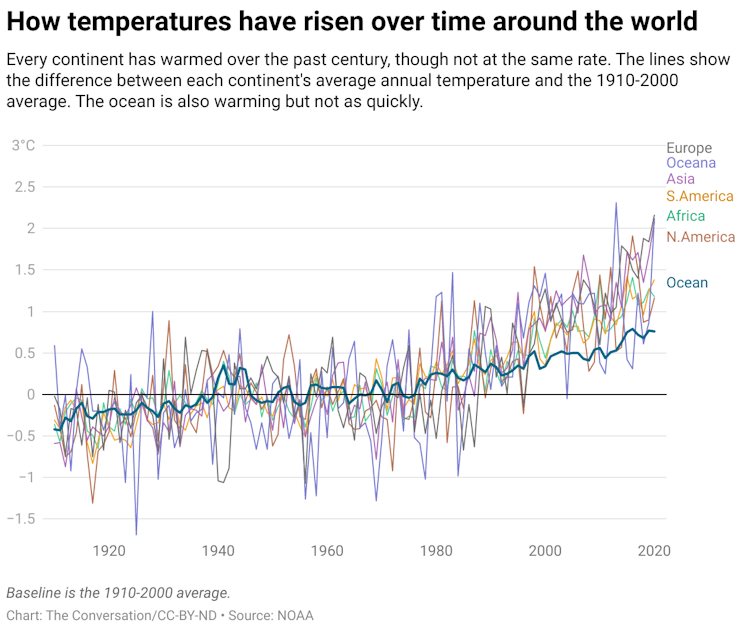|
The injustice of climate change is startling when you see it mapped out. Ethiopia, for example, is home to one of the most vulnerable populations in the world and is a frequent victim of droughts, heat waves and floods that can be worsened by climate change. At the same time, the country emits less than 1/100th the greenhouse gases per person of the U.S., Canada, Australia or Saudi Arabia.
Sonja Klinsky, an environmental scientist at Arizona State University who studies the justice dilemmas of climate policies, explains in a series of infographics why climate change is a justice issue.
A second article looks at injustice from another angle, examining energy inequality and why countries banning financing for fossil fuel projects in Africa isn’t a climate solution when they still support those projects at home. It’s timely as countries at the U.N. climate conference announce new pledges, including one this morning to end financing for overseas fossil fuel projects.
Also today:
|

|
Stacy Morford
Environment + Climate Editor
|
|

Street flooding has become a common problem in some communities.
wokephoto17/Moment via Getty Images
Sonja Klinsky, Arizona State University
Understanding where emissions come from is only one part of the climate justice dilemma.
|
Health
|
-
Janelle R. Goodwill, University of Chicago
The evidence is growing that experiencing both systemic and everyday race-based discrimination may lead some Black Americans to become depressed and think about suicide.
|
|
Economy + Business
|
-
Edouard Wemy, Clark University
The Federal Reserve decided to slow its pace of bond-buying, potentially the beginning of the end of a program that’s been supporting the economy since March 2020.
-
Emily Finchum-Mason, University of Washington
Asking for input is more common than letting stakeholders help set a foundation’s priorities or giving them any say where grant money flows.
|
|
Education
|
-
Ashley Berner, Johns Hopkins University
The controversy over critical race theory is an opportunity for Americans to examine how other democracies deal with diverse viewpoints in public schools, an education policy expert argues.
|
|
Ethics + Religion
|
-
Regina Hansen, Boston University
A scholar of religion in film explains the varied representation of Catholicism in horror. In some films, it is used in the fight against evil, while others show the Church itself as evil.
|
|
Arts + Culture
|
-
Jennifer Tucker, Wesleyan University
Many gun rights advocates claim that the right to carry guns is a universal right that has spanned centuries and nations. History tells a different story.
|
|
Politics + Society
|
-
Michelle S. Phelps, University of Minnesota
Minneapolis residents voted 56% to 44% against an amendment that would have transformed the city’s police. The reasons they did so are complicated, an expert writes.
|
|
Environment + Energy
|
-
Pep Canadell, CSIRO; Corinne Le Quéré, University of East Anglia; Glen Peters, Center for International Climate and Environment Research - Oslo; Pierre Friedlingstein, University of Exeter; Robbie Andrew, Center for International Climate and Environment Research - Oslo; Rob Jackson, Stanford University
Most concerning is the long-term upward trends of CO₂ emissions form burning fossil fuels, which are far from trending towards net-zero by 2050.
|
|
Trending on site
|
-
Morgan Marietta, University of Massachusetts Lowell
The Supreme Court ruled in 2008 that you have a constitutional right to have a gun in your home. Now, the justices will consider how far outside of the home that right extends.
-
Michael Zemcov, Rochester Institute of Technology
Such a mission could be developed soon, allowing astrophysicists to take selfies of the solar system and use the Sun’s gravity as a lens to peer deep into space.
-
Shelly Volsche, Boise State University
Human beings evolved to nurture – and that drive can extend to children who aren’t your own and even to members of other species.
Today’s graphic

From the story, The science everyone needs to know about climate change, in 6 charts
|
|
| |
| |
| |
| |

|
| |
| |
| |
| |
| |
| |
| |
| |
|
|